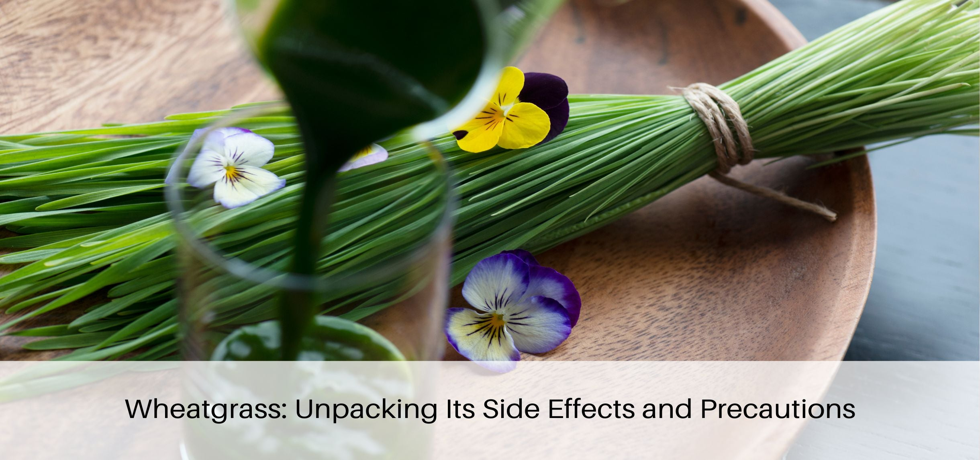
Unveiling the Wheatgrass Enigma: Side Effects Explored
Introduction to Wheatgrass
Wheatgrass has emerged as a popular health supplement, celebrated for its impressive nutrient profile, which includes essential vitamins, minerals, enzymes, and chlorophyll. Whether included in juices, powders, or tablets, many people are turning to this green superfood in hopes of boosting their overall health. However, like all supplements, it is vital to understand the potential side effects of wheatgrass, ensuring a balanced approach to its consumption. In this blog, we aim to unpack the wheatgrass enigma, shedding light on its benefits, side effects, and the precautions you should consider.
The Nutritional Powerhouse: Why Wheatgrass?
Wheatgrass is often hailed as a nutrient powerhouse due to its remarkable concentration of various essential nutrients. Its key components include vitamins A, C, E, and K, alongside a rich selection of minerals and antioxidants. These attributes contribute not only to its popularity as a dietary supplement but also to its status as a potential ally in enhancing skin health. The antioxidants present in wheatgrass may support skin wellness by fighting free radicals, promoting hydration, and even aiding in revitalization. Nevertheless, one must weigh the benefits against the possible side effects.
Navigating the Side Effects of Wheatgrass
While wheatgrass is generally considered safe for most people, it is not without its risks. Some individuals may experience digestive distress, particularly if they have gluten sensitivities or celiac disease. Wheatgrass contains gluten, albeit in small amounts, which can provoke symptoms like bloating, gas, or abdominal pain in sensitive individuals. Furthermore, a sudden increase in dietary fiber from wheatgrass may lead to digestive discomfort such as cramping or diarrhea. To mitigate these risks, it’s advisable to start with small doses of wheatgrass and gradually increase as your body acclimates.
Allergies and Intolerances: Know Your Body
Allergies and intolerances are essential factors to consider when adding any new supplement to your regimen. Wheatgrass may trigger allergic reactions in some individuals, leading to symptoms that can range from skin irritations to gastrointestinal issues. Differentiating between allergies and intolerances is critical; whereas allergies can provoke severe immune responses, intolerances typically cause digestive discomfort. Individuals with a history of allergies should exercise caution when trying wheatgrass for the first time.
Finding the Right Dosage for You
Establishing the right dosage of wheatgrass is crucial to maximizing health benefits while minimizing risks. For beginners, it is advisable to start with smaller amounts, such as one ounce (30 milliliters) of wheatgrass juice daily or a teaspoon of powdered wheatgrass mixed into smoothies. Monitoring your body’s response will help you identify your optimal intake level. Additionally, always look for high-quality wheatgrass sourced from reputable suppliers to avoid contaminants that could compromise your health.
Wheatgrass in Special Populations
Certain populations, such as pregnant women or those with compromised immune systems, should approach wheatgrass with heightened caution. The lack of comprehensive research on wheatgrass consumption during pregnancy calls for a conservative approachconsulting with a healthcare provider can help clarify its suitability given your unique circumstances. Similarly, those dealing with chronic illnesses should consult a doctor before integrating wheatgrass into their health regimen, ensuring personalized recommendations that prioritize their safety.
Conclusion: Embracing Wheatgrass Mindfully
Wheatgrass can be a beneficial addition to your diet, provided it is consumed mindfully. By understanding its potential side effects, respecting individual tolerance levels, and opting for high-quality products, you can safely explore the wheatgrass enigma. Remember, the key to health lies in balance and moderation. Should you have lingering concerns or require tailored guidance, consulting a healthcare professional is always a wise choice.
FAQ
Is wheatgrass safe for everyone?
While many can enjoy wheatgrass without issue, those with gluten sensitivities or other dietary restrictions should approach it cautiously.
While many can enjoy wheatgrass without issue, those with gluten sensitivities or other dietary restrictions should approach it cautiously.
How can I incorporate wheatgrass into my diet?
Start with small amounts, mix it into smoothies or juice, and monitor how your body reacts before increasing the dosage.
What should I do if I experience side effects from wheatgrass?
If you experience any side effects, stop consuming wheatgrass and consult with a healthcare provider for personalized advice.
For professional assistance and expert advice from leading dermatologists like Dr. Hital Patel, experience the benefits of Unveiling the Wheatgrass Enigma: Side Effects Explored with Hair & Skin Specialist Dr. Hital Patel at The Skin Artistry. Our clinics in PDPU Gandhinagar, Vastrapur Ahmedabad, and Hyderabad (Visiting Consultant) offer top-quality care and personalized treatments. Visit us today to learn more about our services and take advantage of our special offers! For more insights, updates, or to collaborate, stay connected with The Skin Artistry.

